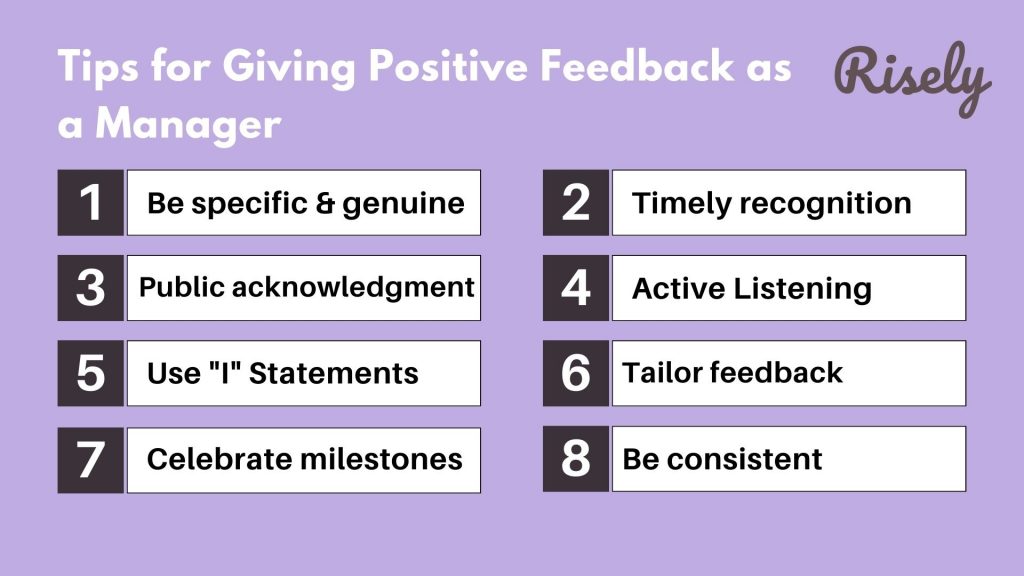10+ Positive Feedback Examples for Managers at Work
Good feedback is the cornerstone of employee engagement and performance. It inspires employees to work hard and strives to improve performance in the team. Feedback is vital for managers to identify areas of strength and room for improvement, but it can also be challenging to get right. While most managers are good at identifying areas of improvement, feedback skills usually lie in the area of recognizing strengths and development opportunities. This blog explains the different types of feedback you can give to employees as a manager and how you can create a feedback loop with your team so that the feedback encourages growth rather than criticism.What is positive feedback?
Positive feedback is a type of feedback that is used to improve the performance of a person, team, or system. Positive feedback is a simple yet powerful tool that can improve employee morale and productivity. It refers to any kind of positive and constructive feedback designed to help someone learn and improve their skills or performance. Positive feedback can take the form of verbal praise, encouragement, and constructive criticism. In addition, it can help employees feel recognized and appreciated for their hard work, leading to good morale and upbeat performance. The purpose of positive feedback is not simply to make people feel good about themselves – it is also intended to help them improve their performance. When given in a constructive manner, positive feedback can help managers learn how to do better and achieve their goals more effectively. It can also help them develop a sense of self-confidence and satisfaction, which can lead to lasting improvements in their work ethic.Now that we understand positive feedback, let’s see how it differs from negative feedback. Read more: How to give constructive feedback to employees?
Other Interesting Reads
How does it differ from negative feedback?
Positive feedback is congratulating a person on doing well and acknowledging the value added by their efforts, while negative feedback is criticizing or reprimanding a person for doing something wrong. It’s essential to use positive feedback only when it is genuinely deserved – otherwise, it can actually have the opposite effect of what was intended. For example, suppose a manager gives negative feedback to a team member for missing deadlines. In that case, the team member may become angry and less likely to return to the manager for their grievances. Conversely, positive feedback that is given with sincerity and without any judgment can go a long way in building trust and encouraging people to take actions that are in their best interest. On the other hand, a constant flow of negative feedback can demotivate employees too. The key lies in the balance.Why should you give positive feedback to employees?
Giving positive feedback is an integral part of managing a team, as it can help to build trust and improve relationships between the team members and their manager. In addition, when feedback is given correctly and constructively, it can help to improve team morale and performance. Sharing positive feedback allows managers to build functional relationships with team members. As a result, they can exchange more honest feedback regularly. The significant benefits can be seen clearly across improved motivation and team satisfaction. In order to give positive feedback effectively, managers must first understand the goals and objectives of their team members. Next, they should identify specific behaviors or actions consistent with those goals and objectives. Finally, they should provide feedback that is specific, objective, and relevant to the situation at hand. Managers should give feedback promptly and consistently, and they should communicate it in a way that is both clear and concise. By providing feedback in this way, managers can help their team members improve their skills and abilities and create a more productive workplace environment.What are the benefits of a positive feedback loop?
Employees need to hear good feedback about their performance to improve and be motivated to perform better. When you give positive feedback, you tell an employee how their performance has exceeded expectations. Giving positive feedback can have several benefits, including improved morale and productivity in the workplace. A positive feedback loop is a cycle in which the feedback recipient learns, improves, and reinforces the behavior that was praised. This cycle can lead to more satisfied employees motivated to continue performing well. By praising employee performance, you can help foster a positive work environment and create a culture of continuous improvement in your business.
Positive Feedback Examples For Managers
- “Great job on the presentation, you put a lot of effort into it, and it showed in the end result. Your attention to detail and ability to clearly communicate the information was impressive.”
- “I appreciate the initiative you took on the project, it was evident that you were actively working to find new solutions to the challenges we faced.”
- “The team really benefited from your leadership during the project, your clear direction and support helped us all to stay focused and on track.”
- “I was impressed by your ability to work well under pressure and still deliver high-quality results.”
- “You have a great talent for building relationships with clients and it was clear that they were comfortable and happy working with you.”
- “You have a great ability to think outside the box, your creative solutions to the problem were not only effective but also innovative.”
- “You have a great attitude towards your work and it is evident in the effort you put into everything you do, it is great to have someone like you on the team.”
- “I appreciate the extra time and effort you put into the project, it was clear that you were committed to making sure it was a success.”
- “You have a great ability to manage your time effectively, it’s evident that you’re able to balance multiple tasks and meet deadlines.”
- “I was impressed by your ability to stay calm and composed during the difficult situation, it was clear that you were able to think clearly and make the best decisions for the team.”
- “Great job on the presentation, you clearly put a lot of effort into it and it showed in the end result. Your attention to detail and ability to clearly communicate the information was impressive.”
- “I appreciate the initiative you took on the project, it was evident that you were actively working to find new solutions to the challenges we faced.”
- “The team really benefited from your leadership during the project, your clear direction and support helped us all to stay focused and on track.”
- “I was impressed by your ability to work well under pressure and still deliver high-quality results.”
- “You have a great talent for building relationships with clients and it was clear that they were comfortable and happy working with you.”
- Find more positive feedback examples here.

Tips for Giving Positive Feedback as a Manager
Here are some tips you as a manager should remember while preparing for a feedback session.- Be specific and genuine: Positive feedback should be specific and sincere. Identify the exact actions, behaviors, or accomplishments that you’re praising. General compliments lack impact, so provide details to make your feedback authentic.
- Timely recognition: Don’t delay positive feedback. Recognize and acknowledge good work as soon as possible after the achievement. This reinforces the behavior and shows you’re attentive to your team’s efforts.
- Public acknowledgment: Publicly praising an employee in team meetings or via company communication can be highly motivating. It boosts the individual’s confidence and encourages others to strive for excellence.
- Active Listening: When delivering positive feedback, actively listen to the recipient’s response. Encourage them to share their thoughts, concerns, or suggestions. This fosters a culture of open communication and mutual respect.
- Use “I” Statements: Frame your feedback with “I” statements to express your observations and feelings. For example, say, “I noticed your exceptional effort on the project, and I’m impressed,” rather than using “you” statements, which can sound judgmental.
- Tailor feedback to individual preferences: Employees may prefer feedback in various forms. Some might appreciate public recognition, while others might prefer private acknowledgment. Get to know your team members’ preferences and adapt your approach accordingly.
- Celebrate milestones: Positive feedback is an excellent way to celebrate achievements and milestones. Whether it’s a work anniversary, project completion, or personal development, acknowledging these moments is essential for team morale.
- Be consistent: Consistency in feedback is crucial. Ensure that you provide positive recognition regularly rather than offering it only occasionally. This reinforces positive behaviors and fosters a culture of appreciation.
Conclusion
When managers give feedback to their team members, they help the employees succeed and meet their personal and team goals. Hence, positive feedback is an integral part of performance management. The feedback shared by managers helps team members understand how they can improve performance and also provides a way to recognize job performance. It also promotes a culture of feedback and innovation in the team.Hone your skills with a free Constructive Feedback toolkit
Grab the free Constructive Feedback toolkit for managers to get powerful samples that make feedback effective!
Positive Feedback Examples FAQs
What is positive constructive feedback?
Positive, constructive feedback involves guiding improvement while emphasizing the employee’s strengths. Offer specific suggestions for growth, remain encouraging, and highlight areas where the individual excels. For instance, “Your presentations are strong; adding more visuals could make them even more impactful. Keep up the great work in engaging the audience with your confident delivery.”
How do you give appreciative feedback?
Appreciative feedback involves expressing genuine appreciation and recognition for a colleague’s contributions and accomplishments. Focus on specific achievements or qualities, be sincere, and use positive language. For example, “I want to commend you on your outstanding presentation skills during the client meeting. Your confidence and clear communication were impressive and contributed significantly to the successful outcome.”
What are examples of positive comments for coworkers?
Examples of Positive Comments for Coworkers:
a. “Your attention to detail on this project is exceptional.”
b. “Thank you for always being willing to help and support the team.”
c. “I admire your creative problem-solving skills.”
d. “Your positive attitude is contagious and makes the workplace more enjoyable.”
e. “You are an excellent communicator, and your clarity in instructions is greatly appreciated.”
a. “Your attention to detail on this project is exceptional.”
b. “Thank you for always being willing to help and support the team.”
c. “I admire your creative problem-solving skills.”
d. “Your positive attitude is contagious and makes the workplace more enjoyable.”
e. “You are an excellent communicator, and your clarity in instructions is greatly appreciated.”
Other Related Blogs
Assertive Feedback Techniques ft. Gurleen Baruah
Assertive Feedback Techniques ft. Gurleen Baruah Let’s be real—giving feedback as a manager isn’t always easy. Say too little, and nothing changes. Say too much, and it might come off…
How to ask for feedback from employees? | Gurleen Baruah
How to ask for feedback from employees? | Gurleen Baruah Feedback is a two way street. This podcast took managers on a trip down the other side. As managers, we…
Let’s Reverse the Gaze of Radical Candor?
Let’s Reverse the Gaze of Radical Candor? Have you heard about Radical Candor? It’s a book by Kim Scott that first came out in 2017. The tagline is “Caring Personally…
How To Become A Leadership Coach In 5 Steps
How To Become A Leadership Coach In 5 Steps Becoming a leadership coach is a fulfilling and rewarding career path for those who are passionate about helping others develop their…


